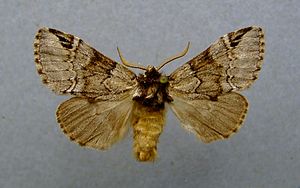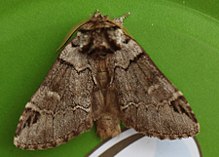Schwarzeck tooth spinner
| Schwarzeck tooth spinner | ||||||||||||
|---|---|---|---|---|---|---|---|---|---|---|---|---|

Schwarzeck toothed spinner ( Drymonia obliterata ) |
||||||||||||
| Systematics | ||||||||||||
|
||||||||||||
| Scientific name | ||||||||||||
| Drymonia obliterata | ||||||||||||
| ( Esper , 1785) |
The Schwarzeck toothed spinner ( Drymonia obliterata ), sometimes also called black spot, is a butterfly ( moth ) from the toothed spinner family (Notodontidae).
features
Imago
The moths reach a wingspan of 30 to 40 millimeters. They have wings colored in different shades of brown. The forewings have the scaled tooth typical of most species of tooth moth on the inner edge. The root field of the forewings is slightly lightened. A dark brown spot in the form of a triangle in the area of the forewing tip distinguishes the moth from the otherwise similar species of the unspotted toothed spinner ( Drymonia dodonaea ), dark gray toothed spinner ( Drymonia ruficornis ) and southern toothed spinner ( Drymonia velitaris ). The palps are short, the trunk withered. The antennae of the males are double combed to the tip, those of the females are slightly serrated. The thorax has an upright head of hair, the abdomen is hairy close-fitting.
egg
The egg is quite small, spherical, flattened at the bottom and whitish in color.
Caterpillar
The caterpillars are whitish green and have light side stripes. These are limited at the top by a fine, red line.
Doll
The doll is colored dark brown.
Similar species
- Dark gray toothed moth ( Drymonia ruficornis )
- Unsullied tooth spinner ( Drymonia dodonaea )
- Southern tooth spinner ( Drymonia velitaris )
Synonyms
- Drymonia melagona
- Ochrostigma melagona
Occurrence
The species is common in Europe, but is absent in Scandinavia, Great Britain and some Mediterranean regions. It lives in different habitats where its forage plants grow, such as B. in light mixed deciduous forests with undergrowth as well as in clearings with oak and beech bushes.
Way of life
The nocturnal moths fly mainly in one generation from late May to early July and in warm places in a second generation in August and September. You are flying towards artificial light sources . When at rest they keep the wings roof-shaped. The caterpillar can be found from July to September. It pupates in a loose web on the ground. The overwintering takes place in the pupal stage. Occasionally the pupa overlaps twice.
Food of the caterpillars
The caterpillars feed mainly on the leaves of oak ( Quercus ) and beech ( Fagus ). They prefer bushes.
Hazard and protection
The species occurs in very different numbers in Germany depending on the region, is rare in some areas, but is not considered to be acutely endangered.
swell
Individual evidence
- ^ A b Walter Forster, Theodor A. Wohlfahrt: The butterflies of Central Europe. Volume 3: Weirdos and Swarmers. (Bombyces and Sphinges). Franckh'sche Verlagshandlung, Stuttgart 1960, DNB 456642196 .
- ↑ a b c Manfred Koch: We determine butterflies. Volume 2: Bears, Spinners, Swarmers and Drills in Germany. 2nd, expanded edition. Neumann, Radebeul / Berlin 1964, DNB 452481929 .
- ^ Drymonia obliterata. Butterflies-Deutschlands.de, Christian Tolasch, accessed on May 23, 2009 .
literature
- Manfred Koch : We determine butterflies. Volume 2: Bears, Spinners, Swarmers and Drills in Germany. 2nd, expanded edition. Neumann, Radebeul / Berlin 1964, DNB 452481929 .
.
- Walter Forster , Theodor A. Wohlfahrt : The butterflies of Central Europe. Volume 3: Weirdos and Swarmers. (Bombyces and Sphinges). Franckh'sche Verlagshandlung, Stuttgart 1960, DNB 456642196 .
Web links
- www.lepiforum.de Taxonomy and photos
- www.lepidoptera.pl dissemination
- Drymonia melagona at Fauna Europaea. Retrieved May 2, 2011
